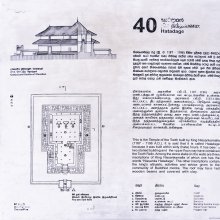Anantanaga, Anantanāga, Ananta-naga: 2 definitions
Introduction:
Anantanaga means something in Hinduism, Sanskrit, the history of ancient India. If you want to know the exact meaning, history, etymology or English translation of this term then check out the descriptions on this page. Add your comment or reference to a book if you want to contribute to this summary article.
Images (photo gallery)
In Hinduism
Purana and Itihasa (epic history)
Source: archive.org: Shiva Purana - English TranslationAnantanāga (अनन्तनाग) refers to the foremost among the Serpents (Nāga), according to the Śivapurāṇa 2.5.2 (“The Prayer of the gods).—Accordingly, as the Gods eulogized Śiva: “[...] Among the Gandharvas you are Citraratha; among the Vasus you are certainly the fire; among the months you are the intercalary month; among the holy rites you are the Caturdaśī rite. Among all lordly elephants you are Airāvata; among all Siddhas you are Kapila; among all serpents you are Ananta (anantanāga) [anaṃtastvaṃ hi nāgānāṃ], among all Pitṛs you are Aryaman. [...]”.

The Purana (पुराण, purāṇas) refers to Sanskrit literature preserving ancient India’s vast cultural history, including historical legends, religious ceremonies, various arts and sciences. The eighteen mahapuranas total over 400,000 shlokas (metrical couplets) and date to at least several centuries BCE.
India history and geography
Source: archive.org: Nilamata Purana: a cultural and literary study (history)Anantanāga (अनन्तनाग) is the name of a sacred spot mentioned in the Nīlamatapurāṇa.—Ananta Nāga is the modern Islāmābād, also known as Anantanāga situated at the foot of the western extremity of the Mārtaṇḍa Plateau.
Anantanāga is a plain where the streams Sandran, Bring, Ārapath and Lidar meet to form the Vitasti river, mentioned in the Nīlamatapurāṇa.—The Vitastā is the most important river of Kaśmīra to give the country the appellation ‘Vaitastika’. Its traditional source is the Nīlakuṇḍa called also Śūlaghāṭa and Vitastātra, but it is actually formed by the streams Sandran, Bring, Ārapath and Lidar meeting in the plain close to Anantanāga near the village Khanabal.

The history of India traces the identification of countries, villages, towns and other regions of India, as well as mythology, zoology, royal dynasties, rulers, tribes, local festivities and traditions and regional languages. Ancient India enjoyed religious freedom and encourages the path of Dharma, a concept common to Buddhism, Hinduism, and Jainism.
See also (Relevant definitions)
Partial matches: Naga, Ananta.
Full-text: Cakramanda, Khandapucchanaga, Gautamanaga, Nilakunda, Lidar, Shulaghata, Sandran, Khanabal, Sleeping, Vitasta, Prasarita, Udvahita.
Relevant text
Search found 3 books and stories containing Anantanaga, Anantanāga, Ananta-naga, Ananta-nāga; (plurals include: Anantanagas, Anantanāgas, nagas, nāgas). You can also click to the full overview containing English textual excerpts. Below are direct links for the most relevant articles:
Lord Hayagriva in Sanskrit Literature (by Anindita Adhikari)
Vishnudharmottara Purana (Art and Architecture) (by Bhagyashree Sarma)
1.3. Elements of Drama (d): Dramatic Postures < [Chapter 3 - Drama and Dance]
Haribhakti-sudhodaya (by Tridandi Sri Bhakti Prajnan Yati Maharaj)
